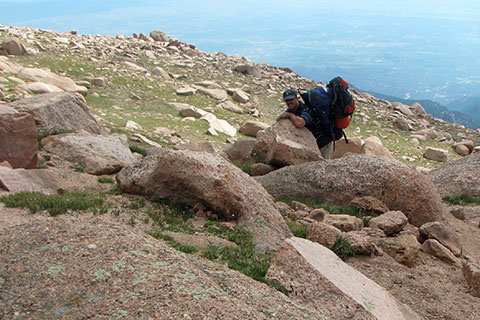| 727 | Self Rescue Be Kind to Yourself |
2012-11-09 |

On the Upper Slopes of Pikes Peak (2011), hiker trying to carry two packs!
My first trip to Pikes Peak was in 2007. We hiked the Barr Trail from Manitou Springs to the Summit and back to our vehicle, as a day hike. It was a big day for us. Our trip was in the middle of September with nearly perfect weather, so the trail was crowded. For many hikers and want-to-be mountaineers, Pikes Peak, America's Peak, is the ultimate training ground. A train and a road to the summit may be used to shorten the length of the long trail. Many folks hike up Pikes and ride the train down, but that is not the only option.
On our trip, when we reached the summit we took a small break. We visited the concessions but did not waste any time because we still had the long hike back down the mountain. As we were nearing the summit trailhead we met a man who had ridden the train to the summit and was going to hike down the mountain to Manitou Springs. He bragged to us about his cleaver plan - he was only going to hike down the mountain. We wished him luck.
My buddy, Ray, and I had cruised to the top, but we were actually dreading the hike back down the mountain. Slowly we re-traced our climb and eventually made it back to the vehicle. I returned to Manitou Springs ahead of Ray, who had stopped to take a nap along the way. As I waited in the parking area, the hiker who had taken the self-professed - easy downhill path, finished the trail. There were tears in his eyes as he hobbled the last few feet. His body was covered with blood, sweat, mud, and tears. He had forced himself down the Barr Trail and the Barr had won! I can still see the look on his face as he quietly unlocked his car and drove away. The hiker had not been kind to himself.
For a good rescue-free hike, you have to be kind to yourself and here are a few tips ...
Plan the trip with respect to the skills and fitness levels of all the participants.
Train before the trip as you simulate the conditions and terrain.
If the environment is different from where you live, you might need to spend a few days acclimating before the trip. Acclimating is important for your body to adjust to the altitude, climate, or terrain.
Have a good partner or hiking group - the longer and more difficult the trail, the more important it is that you have good partners. If you don't get along with someone in the city, you probably won't on the trail either.
Use trekking poles. They are kind to your knees and might also be helpful if someone is injured - to be used as a crutch, splint, etc.
Watch your weight, not only in your own pack, but also in your partners. You don't want to have to carry two packs! (See the above picture. Ouch.)
Wear clothing to match the environment.
Wear proper footwear - well fitted and broken in.
Condition your body to carrying a pack and a weight similar to the one you will be carrying on the trip.
Carry lightweight gear, but remember you still must achieve a certain level of comfort while at camp. Make good smart compromises.
Pack food that you will want to eat.
Know your limits. Gently push the extremes.
Bringing a dog or children on a trip are both more work, but the dependents also make for an enjoyable trip.
Plan trips that will be successful. Practice good habits and slowly increase the limits of your fitness level, knowledge, and judgement as you gain the experience for even bigger and safer trips. This is being kind to yourself!
Happy kind trails
Down is Optional ... Up is Mandatory - introduction
Self Rescue on Trails - the program
Self Rescue - Plan Ahead - plan to prevent
Self Rescue - Be Kind to Yourself - don't make it hard, make it easy
Self Rescue - Be a Lightweight - walk light and easy
Self Rescue - Avoid Huffing and Puffing - listen to your body and control your speed
Self Rescue - Take a Break - give your body a chance to recover
Self Rescue - No Food, No Fuel, No Fun - feed the motor
Self Rescue - Watch Your Time - always know your location, time, and speed